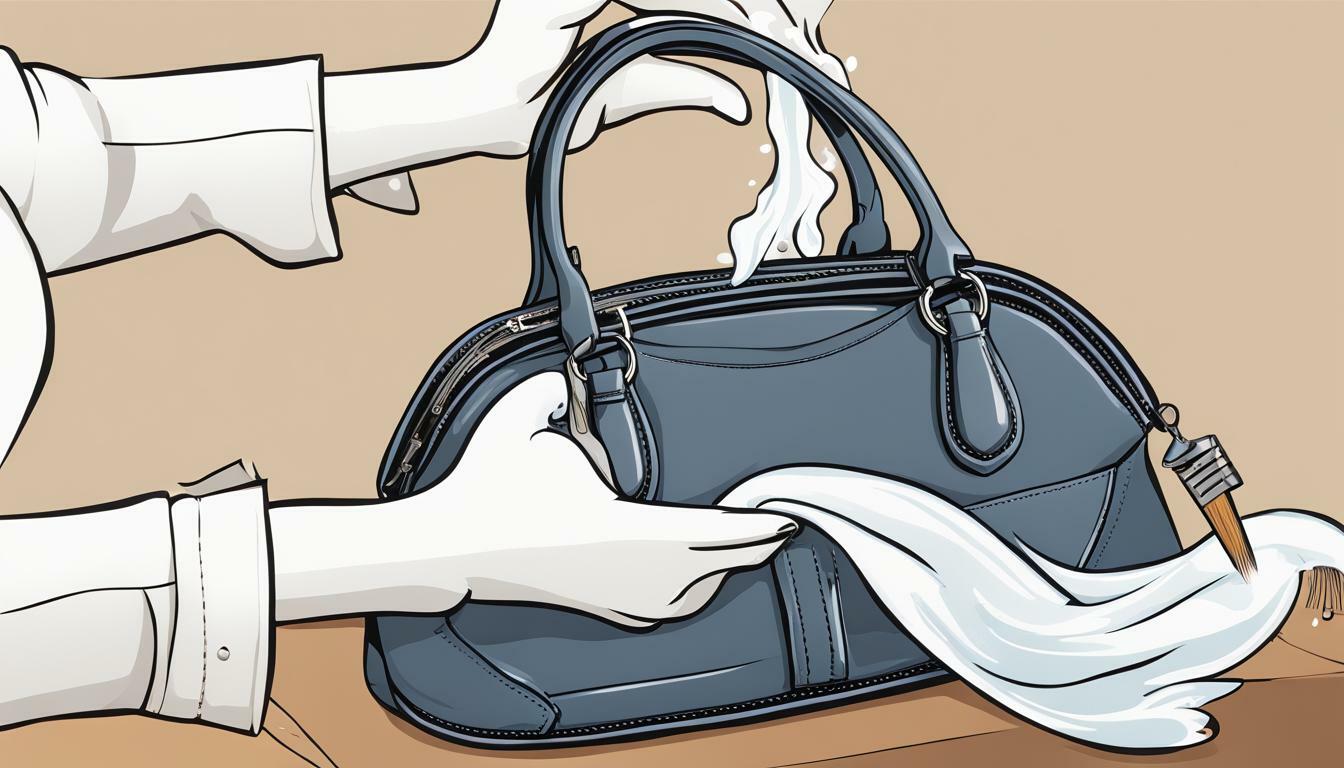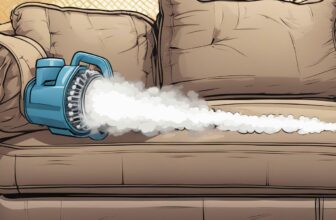
Greetings, leather lovers! If you’re reading this article, chances are you’ve encountered the dreaded water stain on your beloved leather item. No need to panic – removing water stains from leather is a common challenge that can be easily overcome with the right techniques and tips. Leather goods require proper care and attention to maintain their beauty and longevity, and water stains can be particularly problematic. But fear not, dear readers, as I will guide you through the process of removing water stains from leather.
In the following sections, I will explain the nature of water stains on leather, how to assess the severity of the stain, and the different methods for removing them. From DIY techniques like using mild soap and vinegar to commercial stain removers and preventive measures, I’ve got you covered. I’ll also include additional tips and tricks, as well as guidance on seeking professional help should the need arise.
Key Takeaways:
- Water stains on leather can be challenging to remove, but with the right techniques and tips, it can be done.
- Assessing the severity of the water stain is crucial in determining the appropriate method for removal.
- From mild soap and water to commercial stain removers and natural remedies like vinegar and baking soda, there are several methods for removing water stains from leather.
- Preventive measures like waterproofing and regular maintenance can help minimize the occurrence of water stains.
- Seek professional help if the stain is severe or if you’re unsure of the best course of action.
Understanding Water Stains on Leather
As a leather lover, it’s essential to understand the nature of water stains and their impact on your leather goods. Water stains occur when water penetrates the leather, leaving a mark on the surface. Leather is a natural material that can absorb water, but it can also damage it. When water seeps into the leather, it can cause discoloration, stiffness, and even mold growth.
Removing water stains from leather requires a delicate touch and careful attention to detail. While some stains can be removed using DIY methods, severe water damage may require professional assistance.
It’s essential to take proper care of your leather goods to prevent water stains from occurring. Always store your leather items in a dry, well-ventilated place, away from direct sunlight and moisture. Avoid exposing them to water or other liquids as much as possible.
Regularly clean and condition your leather goods to maintain their quality and durability. Use suitable leather cleaners and conditioners for different types of leather, and follow the instructions carefully.
With proper care and attention, you can keep your leather items looking beautiful and free from water stains. In the next section, I will guide you on how to assess the severity of a water stain and determine the best approach for removing it from your leather goods.
Assessing the Severity of the Water Stain
Before attempting to remove a water stain from leather, it is important to assess the severity of the stain. This will help determine the appropriate method for removing the stain and whether professional intervention is necessary.
Start by examining the area around the stain. If the water has spread to a large area or has caused discoloration, it may be necessary to seek professional help.
Next, examine the leather itself. If the water has caused the leather to become stiff or hard, it may be an indication of long-term damage that requires professional assistance. Minor stains, however, can usually be treated at home with simple techniques.
To determine the type of leather and its sensitivity to water or cleaning agents, test a small inconspicuous area first. If the leather reacts negatively, avoid using any harsh cleaning agents and seek professional help.
By assessing the severity of the water stain and taking the appropriate action, you can ensure the best possible outcome for removing the stain and preserving the quality of your leather item.
Preparing the Leather for Stain Removal
Before attempting to remove water stains from leather, it’s essential to prepare the leather surface. First, wipe the leather with a soft, dry cloth to remove any dirt or dust. Then, apply a small amount of water to a clean cloth and gently rub the leather to remove any surface stains. Be careful not to over-wet the leather as this can cause further damage.
Next, use a leather cleaner to deep clean the leather. Apply a small amount of cleaner to a soft cloth and gently rub it into the leather, paying attention to any stained areas. Allow the cleaner to sit on the leather for a few minutes, then wipe it off with a clean, damp cloth.
| Tip: | Choose a leather cleaner that’s suitable for the type of leather you’re treating. Different types of leather require different cleaners, so make sure to read the label carefully. |
|---|
After cleaning, it’s important to condition the leather to keep it soft and supple. Apply a leather conditioner to a soft cloth and rub it into the leather in a circular motion. Allow the conditioner to penetrate the leather for a few minutes, then wipe off any excess with a clean cloth.
| Water Stain Remover for Leather: | There are specific water stain removers available for leather. Look for a product that’s suitable for the type of leather you have and follow the instructions carefully. |
|---|---|
| Best Way to Remove Water Stains from Leather: | Preparing the leather before stain removal is crucial. Without proper preparation, the stain removal process may not work effectively and may even cause further damage. |
By following these steps, you’ll have a clean and conditioned leather surface, ready for the next stage of removing water stains.
Using Mild Soap and Water
One of the simplest methods for removing water stains from leather is to use a mild soap and water solution. This is a quick and easy DIY approach that can be done at home. Here are the steps:
- Mix a small amount of mild soap, such as dish soap or hand soap, with lukewarm water.
- Dampen a clean cloth or sponge with the solution. Be sure to wring out excess water to prevent over saturation.
- Gently rub the stained area with the damp cloth or sponge, using circular motions.
- Rinse the cloth or sponge with clean water and remove any soap residue from the leather.
- Dry the leather thoroughly with a clean towel.
It’s important to note that using too much water or scrubbing too hard can damage the leather. Always test a small, inconspicuous area first to ensure that the soap and water solution does not cause any discoloration or damage to the leather.
If the water stain is particularly stubborn or severe, it may be necessary to try a different method or seek professional assistance.
Applying Vinegar or Lemon Juice
If you’re looking for a natural alternative to remove water stains from leather, vinegar or lemon juice can be a great option. Both of these acidic ingredients have properties that can break down the stain and restore the leather’s appearance.
To use vinegar or lemon juice, start by dabbing a small amount onto a clean cloth. Gently rub the cloth onto the stain, being careful not to oversaturate the leather. Allow the solution to sit for a few minutes, and then wipe it away with a clean, damp cloth.
It’s important to note that vinegar and lemon juice should only be used on light-colored leather, as they can cause discoloration on darker leather. Additionally, these ingredients should be used sparingly and not left on the leather for too long, as they can dry out the leather and cause damage.
However, if used correctly, vinegar or lemon juice can be an effective and affordable way to remove water stains from leather. Test on a small, inconspicuous area first to make sure the solution doesn’t cause any unwanted effects on your leather item.
Pro tip: For a more pleasant scent, you can mix equal parts vinegar and water and add a few drops of essential oil before using it to remove water stains on leather.
Using Commercial Leather Stain Removers
If the water stain on your leather item is significant, you may want to consider a commercial leather stain remover. There are several products available in the market that you can choose from. Before purchasing, make sure to read the label and ensure that the product is suitable for your type of leather.
The best way to remove water stains from leather using a commercial stain remover is to follow the instructions carefully. Usually, you will need to apply the product to a clean, damp cloth and rub it gently onto the stain in a circular motion. Allow the solution to penetrate for a few minutes, then wipe it off with a clean cloth. Repeat the process until the stain is removed.
It’s essential to test the stain remover on an inconspicuous area of the leather item before using it on the water stain. This step helps you determine if the product causes any discoloration or damage to the leather. Also, keep in mind that some commercial leather stain removers can be harsh and cause further damage to the leather.
If you’re unsure which product to use or how to apply it, seek advice from a professional leather cleaner or restorer. They can guide you in choosing the most appropriate product and provide instructions on how to apply it safely and effectively.
Trying Baking Soda or Cornstarch
If you’re looking for an alternative method to remove water stains from leather, try using baking soda or cornstarch. These absorbent substances can help lift the water stain and restore the leather’s appearance.
Note: This method is only effective for minor water stains that have not penetrated deep into the leather.
- Clean the leather with a dry, soft cloth to remove any dust or debris.
- Apply a small amount of baking soda or cornstarch directly onto the water stain.
- Gently rub the powder into the stain using a soft cloth or brush. Be careful not to apply too much pressure, as this could damage the leather.
- Let the powder sit on the stain overnight, allowing it to absorb the moisture.
- Remove the powder with a soft brush or cloth the following day.
- If the stain is still visible, repeat the process until it disappears completely.
Remember to test this method on a small, inconspicuous area of the leather first to ensure it doesn’t cause any discoloration or damage.
While this method can be effective for minor water stains, it may not work for more severe or deep-set stains. In such cases, it’s best to seek professional help to avoid causing further damage to the leather.
Seeking Professional Help
While minor water stains on leather can typically be treated at home using the tips and techniques discussed in this article, there may be scenarios where professional assistance is necessary.
If the water stain is severe or has caused structural damage to the leather, it’s best to consult with a professional cleaner or restorer. These experts have the knowledge and equipment to safely and effectively treat water stains and restore the appearance and quality of your leather goods.
When seeking professional help, be sure to research and choose a reputable provider in the leather care industry. Look for reviews and recommendations from previous customers and verify their qualifications and experience.
It’s also important to consider the cost-effectiveness of professional services and weigh it against the value of the leather item. In some cases, it may be more practical to replace the item instead of investing in expensive restoration services.
Preventing Future Water Stains
After successfully removing water stains from your leather items, it is essential to take steps to prevent future damage. Here are some leather care tips to keep your items looking their best:
- Keep leather items away from water as much as possible.
- Use protective leather sprays or waxes to waterproof your items.
- Avoid exposing leather items to direct sunlight or heat sources.
- Regularly clean and condition your leather items to maintain their quality and suppleness.
- Store leather items in a cool, dry, and ventilated area.
By following these simple tips, you can prevent water stains and other types of damage to your leather items and ensure their longevity.
Additional Tips and Tricks
If you’re dealing with a minor water stain on leather, try using a soft-bristled brush to gently buff the stain away. You can also use a white eraser to gently rub the stain, but be sure to test a small, inconspicuous area first to avoid any potential damage.
If you have suede leather goods that have been affected by water, use a clean and dry cloth to blot up as much moisture as possible. Avoid using water or cleaning products on suede as it can cause discoloration and damage. Instead, use a suede brush or eraser to gently restore the nap of the suede.
Colored leather items can be particularly challenging to treat as the color can come off or fade with certain cleaning agents. As a general rule, avoid using any harsh chemicals or abrasives on colored leather. Instead, use a gentle leather cleaner specifically designed for colored leather and follow the manufacturer’s instructions carefully.
One common mistake to avoid when removing water stains from leather is using too much water or cleaning solution. This can cause the leather to become oversaturated and potentially lead to more damage. Always use the minimum amount of water or solution necessary and use a clean, dry cloth to blot up any excess moisture.
Finally, remember that prevention is key to avoiding water stains on leather. Apply a waterproofing spray or wax to leather items before use, and avoid exposing them to water or excessive humidity if possible. Regularly cleaning and conditioning your leather items can also help maintain their appearance and protect them from future damage.
Conclusion
In conclusion, the process of removing water stains from leather can be a daunting task, but it is not impossible. With the right techniques and tools, anyone can restore the beauty and quality of their leather items.
Throughout this article, I have discussed several methods for removing water stains from leather, including using mild soap and water, vinegar or lemon juice, commercial leather stain removers, baking soda or cornstarch, and seeking professional help.
In addition, I have provided preventive measures to minimize the occurrence of water stains on leather and offered additional tips and tricks for removing water stains. It is essential to remember that immediate action is necessary when faced with water stains to avoid irreversible damage.
Take Care of Your Leather
Remember to take good care of your leather items to maintain their quality and prolong their lifespan. Regular cleaning, conditioning, and protection from water damage are crucial in ensuring the longevity of leather items.
Finally, I hope that the information shared in this article has been useful and will help you get water stain out of leather with ease. Remember to choose the method that best suits your needs and follow the instructions carefully. With a little patience and effort, you can remove water stains from leather and restore your items to their original state.
Thank you for reading.
FAQ
Q: Can I use regular soap to remove water stains from leather?
A: Using mild soap and water is a common method for removing water stains from leather. However, it is important to choose a soap that is gentle and does not contain harsh chemicals or additives that could damage the leather. Make sure to follow the proper technique and precautions when using this DIY approach.
Q: Will vinegar or lemon juice help remove water stains from leather?
A: Yes, vinegar or lemon juice can be effective in removing water stains from leather. These natural ingredients have acidic properties that can help break down the stain. It is important to dilute the vinegar or lemon juice and follow the step-by-step instructions to ensure safe and effective stain removal on leather.
Q: Are commercial leather stain removers recommended for water stains?
A: Yes, commercial leather stain removers can be a good option for removing water stains from leather. There are various products available in the market, each with their own key features. It is important to choose the most suitable one for your specific water stains and follow the recommended application instructions.
Q: Can baking soda or cornstarch be used to remove water stains from leather?
A: Baking soda or cornstarch can be alternative methods for removing water stains from leather. These absorbent substances can help lift the water stain and restore the leather’s appearance. Follow the step-by-step instructions to properly use baking soda or cornstarch for stain removal on leather.
Q: When should I seek professional help for removing water stains on leather?
A: If the water stain on your leather is severe or if you are unsure about the proper removal technique, it is recommended to seek professional help. Professional cleaners or restorers have the expertise and experience to handle challenging water stains on leather. Consider the cost-effectiveness of professional services for your specific situation.
Q: What can I do to prevent future water stains on leather?
A: To prevent future water stains on leather, it is important to take preventive measures. Protect leather goods from water damage by avoiding exposure to moisture and using suitable products for waterproofing leather. Regular maintenance and care, such as cleaning and conditioning, are also essential to minimize the occurrence of water stains and prolong the lifespan of leather items.
Q: Are there any additional tips and tricks for removing water stains from leather?
A: Yes, here are some additional tips and tricks for removing water stains from leather:
– Try quick remedies for minor stains, such as gently rubbing the stained area with a clean cloth or using a blow dryer on low heat.
– Be cautious when dealing with suede or colored leather, as certain cleaning methods may not be suitable.
– Avoid common mistakes such as excessive rubbing or using harsh chemicals, as they can damage the leather. Follow the proper techniques and precautions to ensure successful stain removal on leather.





